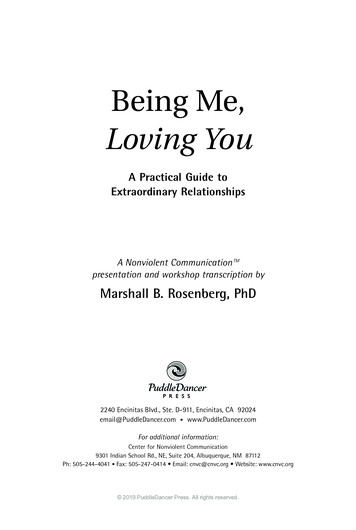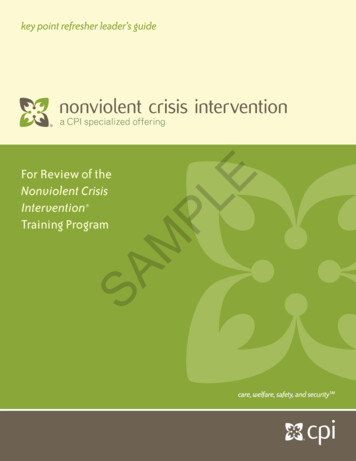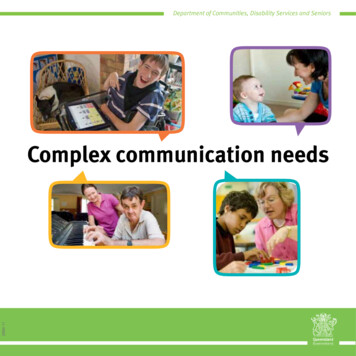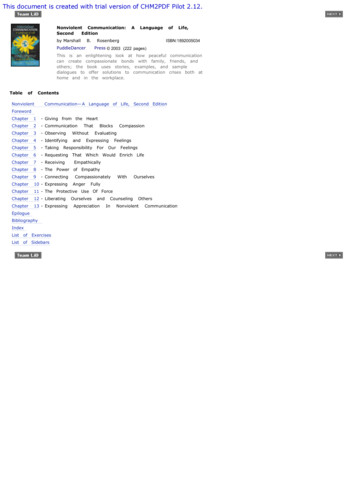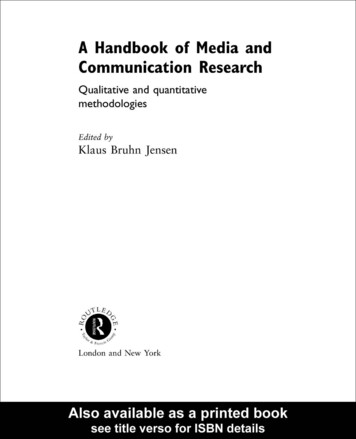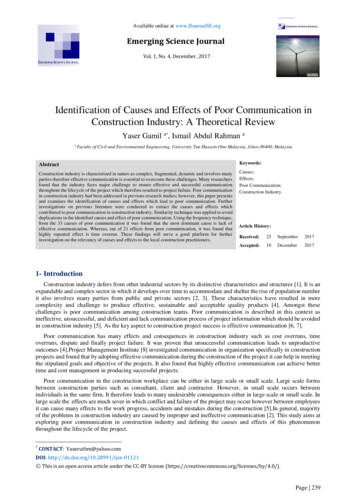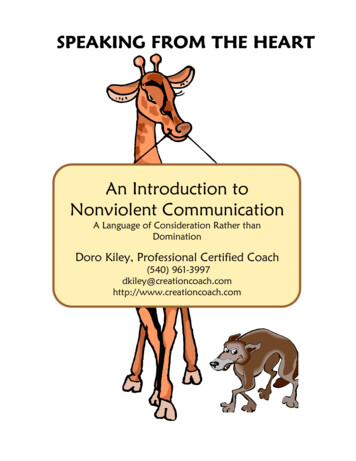
Transcription
SPEAKING FROM THE HEARTAn Introduction toNonviolent CommunicationA Language of Consideration Rather thanDominationDoro Kiley, Professional Certified Coach(540) ncoach.com
Introduction to Nonviolent CommunicationA Language of Consideration Rather than DominationDoro Kiley, Professional Certified Coach (540) 961-3997 omNonviolent Communication (NVC) is a process of connecting with people in a way thatallows everyone’s needs to be met through empathizing with the universal needs we all share.It is a way of relating to ourselves and others out of an awareness of feelings and needs ratherthan judgments, labels, punishment, guilt or shame.At the heart of NVC is the ability to connect to our own ‘humanness’ and to the“humanness” of others. It is to see ourselves and each other not as objects or as ‘good’ or“bad,” but as whole, dynamic persons with varying combinations of feelings and needs. Whenwe can express that which is alive in us in a nonjudgmental, non-blaming way we have a muchgreater chance of inspiring an empathic connection with others because as humans we all sharethese same qualities; e.g. the needs for trust, safety, appreciation, caring, freedom the listgoes on. When empathy is experienced in connection to another person (or to ourselves) we,as humans, have a natural desire to improve the life of that person. Within this connection anexchange can take place that greatly enhances the chances of getting everyone’s needs met.THE JACKAL AND THE GIRAFFETHE JACKAL:In NVC we use the Jackal to symbolize the life alienating, domination language most of uswere raised with. The jackal, as an animal, is low to the ground, a scavenger, competitive andvicious. A jackal as a person is one who approaches people (including themselves), places andthings through the lens of a Right/Wrong, Good/Bad judgments. They speak a language thatinstills fear, anger, guilt and shame. It often inspires painful obsessions and behaviors. Thejackal sees everything as deserving either reward or punishment for themselves or others. Theirlanguage is demanding; “Do this.” “Don’t do that.” The jackal lives in their head judging,analyzing and blaming themselves and others.THE GIRAFFE:In NVC we use the Giraffe to symbolize the life serving, partnership language that inspiresconnection and community. The giraffe is a very powerful yet peaceful, gentle animal. It hasthe largest heart of any land animal on earth and the longest neck which allows for a far,overall view of the world around it. To speak ‘giraffe’ is to speak from the heart. A giraffeperson is non-judgmental, non-blaming, non-demanding and non-threatening. A giraffe isobjective in their view and understanding of their feelings and needs as well as the feelings andneeds of others. They practice empathy and desire to make life more wonderful for themselvesand those around them.Purpose of NVC To evoke an empathic, natural connection so that all needs may be met1
To consider and to connect to the life in ourselves and othersTo be inspired and to inspire others to give out of the natural joy of givingBackground of NVC Founded by Marshall Rosenberg during the Civil Rights era; influenced by CarlRogersThe Center for Nonviolent Communication, founded in 1984, has internationalpresence in such places as the Middle East, Bosnia, Rwanda, Columbia,Indonesia, Malaysia, Sri Lanka, Nigeria, Sierra Leone, India, Western Europe,and more.Most frequent applications include school systems, health care, prisons,workplaces, law enforcement & military, drug treatment & social services,families.NVC - Based on 2 Principles1.Principle #1 –Nurturing Our NatureWe hold an acknowledgement that domination thinking and violence have beentrained and habituated into us in a poor attempt to control others and be controlledby others. The basic premise of NVC is that this unskillful training, thoughthousands of years old, is not our true nature. Gandhi once said, “Don’t mistakehabit for what is natural.” NVC is taught on the underlying supposition that ourtrue nature is one of desire to make life more wonderful for ourselves and others.Unfortunately most of us have lost the skill and know-how to fulfill this desire.NVC is as much a process of unlearning old, unskillful reactions as it is gainingnew tools and developing new responses.2.Principle #2 No One Makes You FeelWe understanding that we are responsible for our own reactions to any givensituation. Example: If identical triplets are on a beach and a wave comes andcrashes down on them and recedes, one of the triplets may be exhilarated, thrilledand laughing, one may be furious, resentful and yelling while the third isdespondent, frightened and crying. What made the difference? The differencecomes not from what happened but rather from the fact that each of them hasdifferent needs, expectations, values and perceptions. The same can be said for anysituation or interaction. It’s not that something or someone makes you feelanything but rather your needs are being met or not met.NVC ModelThe Four Components of NVCThe first 3 components - observations, feelings and needs - make up the first part of the2
empathy process. This is a process of objectively identifying what’s really alive in you oranother person. It’s an exploration of what ‘is’ without blame, judgment or analysis. Itinvolves:1. Observation (free of judgment, labels, diagnosis, opinions, etc.)”When I see/hear/notice ”2. Feeling (free of thoughts, not “I feel like.” or “I feel that ” We are also carefulnot to use ‘jackal’ words that imply blame such as bullied, ignored, cheated,betrayed, abandoned, victimized )” I feel ”(happy, sad, delighted, frightened, surprised, angry, content, confused, thankful,anxious, affectionate, resentful, intrigued, overwhelmed, thrilled, etc )3. Need (universal; without reference to any specific person, time, activity)” because I am needing ”(trust, appreciation, freedom, understanding, connection, safety, hope,consideration, equality, integrity, respect, acceptance, autonomy, etc )The fourth component - the request - is the ‘dance’ that allows life to move forward. It presentsthe opportunity to make life more wonderful by moving toward a joyful resolution. The requestis the ebb and flow of giving and receiving, back and forth, that provides the opportunity foreveryone’s needs to be met.NOTE: It’s important to remember that if you are the one expressing what’salive in you then your request will always immediately follow yourobservations, feelings and needs. However, if you are the one providingempathy to someone else then you will not make a request until you’ve beengiven a ‘sign’ or have been asked to make a request.4. Request (clear, positive, present, detailed, active request that would enrich life)”Would you be willing to ?”Jackal Example:Person #1: You never listen to me when I’m talking to you. You’re ignoring me constantly.You just don’t care!Person #2: Yeah right! I listen to you all the time!Person #1: You can’t listen to me and read the paper at the same time! You’re so unreal!Person #2: I’m unreal?! You don’t even . (discussion goes nowhere and ends in frustration)Giraffe Example:Person #1: When I see you read the newspaper while I’m talking, I feel frustrated becauseI’m needing to be heard. Would you be willing to close the newspaper for 5minutes and hear my idea?3
Person #2: When you ask me to close the paper when I’m reading an article that is veryimportant to me I feel anxious because of my need to understand what’s going onin the world. I also feel concerned because of my need for your well-being.Would you be willing to wait 5 minutes while I finish this article so I can give youmy full attention?Person #1: Yes.Two Parts of NVC1. RECEIVING EMPATHYHonestly EXPRESS your clear, nonjudgmental observations, your own feelings andneeds; being aware of what’s alive in youo Ongoing awareness of observations, feelings and needs: “When I hear (see) Ifeel .because I need . Would you be willing to ?”o Willingness and courage to express those feelings and needs (vulnerability)o Willingness to make clear, detailed requests2. PROVIDING EMPATHYEmpathically LISTEN to other’s observations, feelings and needso Presence, Focus, Space, Verbal reflection of feelings & needs:, “Are youfeeling ?”, “Are you needing ?”o NOT advising, fixing, consoling, story-telling, sympathizing, analyzing,explaining, defending.o No matter what is said, hear only feelings, needs, observation & requests.o Make a request ONLY after being given a ‘sign’ or asked to do so.SELF EMPATHYTransforming the Pain of Unmet NeedsTransforming our relationships often involves transforming ourselves at the same time. When2 (or more) people are in pain because their needs aren’t being met it may seems like a stalemate; no one has enough empathy to get the ball rolling. In this situation self empathy is a toolto begin with. This practice can be done as many times as needed to soften the hard defensesand open the heart. It may take a minute, a day or two, sometimes more. You may chose tomake it a daily practice which would be optimal.1. Take Time & Space: When you are in pain take some time, create a space alone andundisturbed where you can write (or type) freely.2. The Jackal Show: Just start writing. Don’t watch your words or try to “be nice”. Justlet it flow. This is called the Jackal Show. You can write all about what ‘they’ havedone to you, what they have created, what they’ve destroyed. You can express all yourpain and anguish, your fears and outrage, your judgments, thoughts, analysis of thesituation and whatever else comes to mind. Do this until you have nothing left to say.3. List the Jackal Words: Go back over what you’ve written. What are the jackal wordsthat come to mind? Make a list of the jackal words that imply blame such as; bullied,4
ignored, cheated, betrayed, abandoned, victimized 4. Translate Jackals into Baby Giraffes: Go back over your jackal list. What are thereal feelings behind all this? Make another list using your list of jackal translations.Remember that no one makes you feel anything. Your feelings are your own and are theresults of your perceptions, beliefs and attitudes. Go behind the jackal words and get areal sense of the feeling words that describe what is going on in your body now such as;sad, frightened, angry, worried, confused, anxious, overwhelmed, bitter, jealous, etc Use the Feelings List and pick out the words that describe the way you really feel.Each feeling is a baby giraffe crying with an unmet need. Feel them, listen to them.What are they trying to say? What needs are not being met?5. List the Needs (not the strategies) Behind the Feelings: In this next list write down theunmet needs (not strategies) behind all these feelings such as; respect, appreciation,intimacy, recognition, cooperation, support Use the Needs List to pick out the needsyou have that are not being met. Remember these needs are not specific to any oneperson. An example of a need would be, “I need understanding.” An example of astrategy is, “I need you to understand me.” List only the needs not the strategies.6. Mourning: Allow yourself to mourn the fact that these needs are not presently beingmet. Be with yourself. Give yourself permission to feel the pain of not having theseneeds met. It is painful. Hold your pain like you would hold a baby. If anger andresentment persist for a long time go back to writing more of the Jackal Show. Oftenonce we have completed the first step a shift will take place and suddenly anger feelsmore like sadness. List the new feelings. List the needs behind those feelings. Andallow yourself to mourn your loss again.Empathy: When you feel complete with the above exercises allow yourself to sit back. Theword “Empathy” implies an empty presence – an awareness of what is alive in you. Bring yourawareness into your body. Every thought and emotion we have is manifesting in the bodysomewhere. Scan your body with all your senses gently and locate the places where you’reholding your pain. Don’t try to change anything. Just be empathic. Is your brow furrowed?Your shoulders tight? Your throat constricted? Your abdomen tight? Is your breathingshallow? When you find a place that is holding your pain just be present with it. If yourshoulders suddenly relax, let them go. If your face muscles soften let it be. If your abdomensoftens, breathe.NVC Resources If you want to learn more about NVC Center for Nonviolent Communication: www.cnvc.org(Information, books, videos, audio tapes, training event listings, etc) Book: Nonviolent Communication by Marshall Rosenberghttp://www.puddledancer.com/5
Nonviolent Communication (NVC) is a process of connecting with people in a way that allows everyone's needs to be met through empathizing with the universal needs we all share. It is a way of relating to ourselves and others out of an awareness of feelings and needs rather


